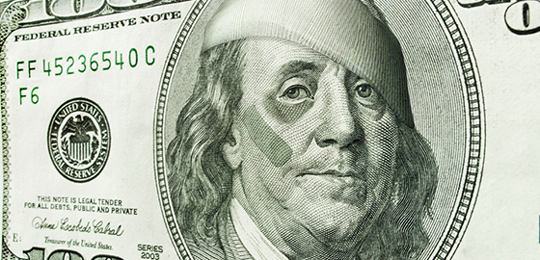The Worst Economy Ever?
Like an army that has outdistanced its supply lines, the stock market runs far ahead of logistical support.
Total market capitalization of U.S. stocks presently ranges to $40 trillion — or twice GDP.
This 2-1 ratio is the highest in history… we might mention.
Analyst John Hussman reminds us the ratio previously topped at 1.9 in 2000.
That is, never before has Wall Street run so far ahead of Main Street.
But like Napoleon racing for Moscow after Borodino, an overextended army is a vulnerable army.
The Grande Armée went into Russia some 450,000-strong in June 1812.
Perhaps 22,000 sad caricatures of humanity staggered out later that year.
We believe the stock market is marching toward its own Moscow… and a similar retreat.
Soon or late it will come limping back — broken, bandaged… beaten.
Main Street cannot maintain the pace of advance.
The Economy Is Advancing in the Wrong Direction
Reuters informs us that government bean counters will likely downgrade their initial 2.6% Q4 2018 GDP estimate.
Falling construction spending is the central explanation on offer.
The unhappy trend will likely continue into Q1 2019.
Goldman now projects 0.9% Q1 GDP growth.
The Federal Reserve’s New York headquarters has it at 0.88%.
And its Atlanta branch now estimates Q1 growth of merely 0.3%.
The Atlanta outfit is known, incidentally, for its blue-sky, cockeyed optimism.
Meantime the American consumer has reached his maximum endurance, and is falling out of rank… exhausted.
In December U.S. credit card debt scaled $870 billion — its highest ever amount.
Similarly, auto loan interest rates teeter at eight-year heights. And a record number of Americans are at least 90 days in arrears of payment.
In all, aggregate household interest payments have spiked to a 15% year-over-year rate.
As Zero Hedge reminds us, recession is on tap nearly every occasion when interest payments rise with such extravagance.
All the while, retail stores are shuttering their doors at a record clip.
We haven’t the heart to continue.
Michael Snyder of The Economic Collapse blog does:
Debt delinquencies are at unprecedented levels, bankruptcies are soaring, retail stores are closing at a record pace; this is the worst economy for farmers since the early 1980s, exports are plummeting and a brand-new real estate crisis has now begun.
Then Why Are Stocks Still So Expensive?
Yet stocks remain in what our old colleague David Stockman labels the “nosebleed section of history.”
The Shiller P/E ratio is a widely recognized barometer of stock market prices.
Stretching through history, its mean score is 16.9.
Even after last year’s near-bear market, today it rises to 30.7 — 81% above the mean.
It is also within an ace of October 1929’s 32.6.
Only 1999’s infinitely obscene 44 outpaces it.
But do today’s economic conditions justify an altitude-induced nosebleed?
The evidence here assembled shouts no.
Yet there they are.
And so a rose blooms from a turnip seed.
But let us take the longer view…
The stock market has been on the march since 2009, with only occasional reversals.
Have underlying economic conditions warranted the ground gained?
“The Current Economy Has Underperformed the Worst Economy”
Jeffrey Snider of Alhambra Investments has compared and contrasted this past decade to decades past.
He notes first that real GDP expanded at an 18.85% cumulative rate, 2007–2018.
Nothing, perhaps, to pound a kettle drum about — but growth it is.
Maybe you are of an age to recall the ghastly stagflation of the 1970s.
At least this past decade has turned in real growth, you say — unlike the inflation-hobbled decade of bell-bottomed trousers and gasoline lines.
You are forgiven for thinking it. But you are far off the facts…
Real GDP expanded 38% between 1969 and 1980 — over double the past 11 years’ 18.85%.
Again, we refer to real GDP. Unlike nominal GDP, it accounts for inflation’s false fireworks.
Just so, you argue.
But the past decade is still miles better, for example, than the locust years of the Great Depression.
Unemployment scaled a hellish 25%. Unemployment never exceeded 10% during the Great Recession.
All comparisons fall short, you continue.
Ah, but once again, have another guess…
Snider reminds us that real GDP 1929–1940 expanded at a cumulative 19.89% rate — outstripping the most recent 11 years’ 18.85%.
Impossible! You howl.
But the facts are the facts.
The Great Depression’s valleys may have been steeper, the winds icier, the hunger more acute.
But it had its years of 12.9% growth… 10.8%… 8.8%… and 8.0%.
Though excluded from our sample, 1941 GDP expanded a sky-shooting 17.7%.
Meantime, not a single one of these past 11 years can crack 3%.
The United States economy appears to be down with a wasting disease.
This, despite maximum efforts of the Federal Reserve and its trillions of dollars of assistance.
Snider:
What is now established, though, is a mathematical fact. The last 11 years have been worse than the Great Depression. According to the updated estimates, using 2012 dollars as a reference, the current economy has underperformed the worst economy.
Mr. Stockman phrases it in terms harsher yet:
After one decade of the most massive combined monetary and fiscal stimulus in U.S. history, the real growth rate at 1.5% per annum is lower than it’s ever been, even during the 1930s!
Something is not right.
Today’s Stock Market vs. Previous Stock Markets
Economically, we have stacked the past 11 years alongside the 11 years 1969–1980 and 1929–1940.
And we have found them wanting sorely in comparison.
Meantime, the S&P has gained over 300% since bottoming 10 years ago this very day — March 6, 2009.
Shall we compare today’s stock market performance with the Great Depression and 1970s?
The stock market was a seesaw affair for much of the 1930s.
But in nominal terms, it required 25 years of hard labor to recover from the shock of ’29.
Not until 1954 did it recapture its 1929 heights.
Meantime, the present stock market required only six years to reclaim its 2007 highs.
But we cannot asribe this pleasant fact to the economy.
GDP growth averaged 1.14% between 2009 and 2013.
What about the “lost” decade of the 1970s?
Recall that real GDP gains 1969–1980 more than doubled real GDP 2007–2018.
The Dow Jones opened 1969 at roughly 6,500. It opened 1980 near 2,850.
The S&P plunged from 740 to 360 across the same space.
For the stock market, the decade was well and truly lost.
So lost was it that Business Week ran a 1979 cover story pronouncing “The Death of Equities.”
In a peanut shell:
Real GDP 1969–1980 more than doubled real GDP 2007–2018.
But the stock market 2007–2018 at least tripled the stock market 1969–1980.
Should not the opposite be true?
Perhaps this curious fact owes to the multiple rounds of quantitative easing that vastly inflated the stock market post-2008?
Those same multiple rounds of quantitative easing yielded bits… scraps… leavings for the Main Street economy.
Time, the Great Equalizer
But time equalizes as nothing else.
Scales balance, what goes up comes down, what goes down comes up…
The mighty fall, mountains crumble, the meek inherit the earth.
We suspect stock market and economy will meet again on fair ground.
Stock market will likely fall to the level of economy before economy rises to the level of stock market.
But if the gods are kind, no time soon…
Regards,
Brian Maher
Managing editor, The Daily Reckoning



Comments: